Benefit Analysis of Gamified Augmented Reality Navigation System
Abstract
:1. Introduction
2. Related Work
2.1. Benefits of AR
2.2. AR Navigation Technology
2.3. Gamified AR Navigation
3. Methodology
3.1. AR Navigation System
3.1.1. Artwork Label Scanning
3.1.2. Two Navigation Modes
3.1.3. Uploading of Behavioral Data to the Cloud
3.2. Experimental Design
4. Data Analysis
4.1. Viewing Time
4.2. Distance Travelled
4.3. Path Analysis
5. Discussion
5.1. Analysis Results
- Due to current issues with technologies combining AR and GPS, the AR guide’s position shifted even when the user was standing still. Thus, this method is not recommended for outdoor venues. These contexts would be better served by fixed-location display methods, in which the virtual guide is displayed after images are scanned at each exhibit.
- Analysis showed no significant differences between the participants in terms of time or distance travelled, meaning that gamification did not impact the personal pace of the participants or the time they spent viewing the exhibition, and the overall distance that the participants travelled did not differ significantly. This means that using gamification to control the time spent viewing exhibits or distance travelled by visitors would be difficult.
- The paths presented by the participants using gamified AR were more regular, and therefore we can speculate that visitors follow the gamified path instructions while viewing exhibitions. This is a significant finding, as it can be applied to divert crowd flows. However, the starting points of the participants remained scattered. We speculate that this was because the participants needed time to familiarize themselves with the map and because their smartphone hardware and GPS positioning conditions can affect AR stability. This requires improvement.
5.2. Research Limitations
- Since this study is still based on mobile devices that are easily available to users and support general AR technology, devices that can enhance AR positioning quality or experience such as Bluetooth beacons, smart glasses, or edge-based SLAM applications are not within the scope of this study.
- The objective of this study was to represent the real behavior of exhibition visitors using a gamified AR navigation system. Thus, no guidance or assistance from staff members was provided, which means interruptions or other behaviors beyond exhibition viewing were unavoidable. These behaviors were not within the scope of this study.
- Exhibitions manifest in a myriad of forms. This study focused on AR-aided navigation in which visitors moved from exhibit to exhibit using a gamified approach and by following the guidance of a virtual AR guide outdoors. The results provide reference for other exhibitions and studies employing a similar approach but cannot be generalized to all types of AR navigation.
- The limitations of existing AR and GPS technologies mean that not all of the participants had optimal AR guide quality and effects. These limitations included varying smartphone hardware specifications and external environmental factors such as internet connection quality, weather, and overhead cover. These may affect the persistence and promotion of AR navigation system use.
6. Conclusions
Funding
Institutional Review Board Statement
Informed Consent Statement
Data Availability Statement
Acknowledgments
Conflicts of Interest
Appendix A
Appendix B
References
- Lee, C.-I.; Xiao, F.-R.; Hsu, Y.-W. Using Augmented Reality Technology to Construct a Venue Navigation and Spatial Behavior Analysis System. In Proceedings of the 5th International Augmented and Virtual Reality Conference, Munich, Germany, 12–14 June 2019; pp. 161–170. [Google Scholar]
- Lee, C.-I.; Xiao, F.-R.; Hsu, Y.-W. AR Book-Finding Behavior of Users in Library Venue. Appl. Sci. 2020, 10, 7349. [Google Scholar] [CrossRef]
- Damala, A.; Cubaud, P.; Bationo, A.; Houlier, P.; Marchal, I. Bridging the gap between the digital and the physical: Design and evaluation of a mobile augmented reality guide for the museum visit. In Proceedings of the DIMEA ’08 3rd International Conference on Digital Interactive Media in Entertainment and Arts, Athens, Greece, 10–12 September 2008; pp. 120–127. [Google Scholar]
- Billinghurs, M.; Belcher, D.; Gupta, A.; Kiyokawa, K. Communication behaviors in colocated collaborative AR interfaces. Int. J. Hum.-Comput. Interact. 2009, 16, 395–423. [Google Scholar] [CrossRef]
- McCall, R.; Wetzel, R.; Löschner, J.; Braun, A.-K. Using presence to evaluate an augmented reality location aware game. Pers. Ubiquitous Comput. 2011, 15, 25–35. [Google Scholar] [CrossRef]
- Swan, J.E.; Gabbard, J.L. Survey of user-based experimentation in augmented reality. In Proceedings of the 1st International Conference on Virtual Reality, Las Vegas, NV, USA, 22–27 July 2005; pp. 1–9. [Google Scholar]
- Dünser, A.; Grasset, R.; Billinghurst, M. A survey of evaluation techniques used in augmented reality studies. In Proceedings of the ACM SIGGRAPH ASIA 2008 Courses, Singapore, 10–13 December 2008. [Google Scholar]
- Dey, A.; Billinghurst, M.; Lindeman, R.W.; Swan, J.E., II. A Systematic Review of 10 Years of Augmented Reality Usability Studies: 2005 to 2014. Front. Robot. AI 2018, 2016, 37. [Google Scholar] [CrossRef] [PubMed] [Green Version]
- Dias, M.; Jorge, J.; Carvalho, J.; Santos, P.; Luzio, J. Usability evaluation of tangible user interfaces for augmented reality. In Proceedings of the 2003 IEEE International Augmented Reality Toolkit Workshop, Tokyo, Japan, 7 October 2003. [Google Scholar]
- Drab, S.; Artner, N. Motion Detection as Interaction Technique for Games & Applications on Mobile Devices. In Proceedings of the Interaction Devices (PERMID 2005) Workshop, Munich, Germany, 11 May 2005. [Google Scholar]
- Moore, D. A Real-World System for Human Motion Detection and Tracking; California Institute of Technology: Pasadena, CA, USA, 2003. [Google Scholar]
- Diaz, E.M. Inertial Pocket Navigation System: Unaided 3D Positioning. Sensors 2015, 15, 9156–9178. [Google Scholar] [CrossRef] [PubMed] [Green Version]
- Saponas, T.S.; Lester, J.; Hartung, C.; Kohno, T. Devices that Tell on You: The Nike + iPod Sport Kit; University of Washington: Seattle, WA, USA, 2006. [Google Scholar]
- AGO. REBLINK. Available online: https://ago.ca/exhibitions/reblink (accessed on 1 February 2022).
- Quimby, J. Explore Museums in a New Way with Tango. Available online: https://blog.google/products/google-ar-vr/explore-museums-new-way-tango/ (accessed on 1 February 2022).
- Kastrenakes, J. Google’s Project Tango is Shutting down because ARCore Is already Here. Available online: https://www.theverge.com/2017/12/15/16782556/project-tango-google-shutting-down-arcore-augmented-reality (accessed on 1 February 2022).
- MoNTUE. YŌGA: Modern Western Paintings of Japan. Available online: https://montue.ntue.edu.tw/en/exhibition-yoga/ (accessed on 1 February 2022).
- Huotari, K.; Hamari, J. Defining Gamification—A Service Marketing Perspective. In Proceedings of the 16th International Academic MindTrek Conference, Tampere, Finland, 3–5 October 2012. [Google Scholar]
- Deterding, S.; Dixon, D.; Khaled, R.; Nacke, L. From game design elements to gamefulness: Defining “gamification”. In Proceedings of the 15th International Academic MindTrek Conference, Tampere Finland, 28–30 September 2011; pp. 9–15. [Google Scholar]
- Hamari, J. Transforming homo economicus into homo ludens: A field experiment on gamification in a utilitarian peer-to-peer trading service. Electron. Commer. Res. Appl. 2013, 12, 236–245. [Google Scholar] [CrossRef]
- Hamari, J.; Shernoff, D.J.; Rowe, E.; Coller, B.; Asbell-Clarke, J.; Edwards, T. Challenging games help students learn: An empirical study on engagement, flow and immersion in game-based learning. Comput. Hum. Behav. 2016, 54, 170–179. [Google Scholar] [CrossRef]
- Hamari, J.; Koivisto, J. Measuring flow in gamification: Dispositional Flow Scale-2. Comput. Hum. Behav. 2014, 40, 133–143. [Google Scholar] [CrossRef]
- Roccetti, M.; Marfia, G.; Varni, A.; Zanichelli, M. How to Outreach the External World from a Museum: The Case of the Marsili’s Spirit App. In Proceedings of the International Conference on Arts and Technology, Milano, Italy, 21–23 March 2013; pp. 25–32. [Google Scholar]
- Paliokas, I.; Patenidis, A.T.; Mitsopoulou, E.E.; Tsita, C.; Pehlivanides, G.; Karyati, E.; Tsafaras, S.; Stathopoulos, E.A.; Kokkalas, A.; Diplaris, S.; et al. A Gamified Augmented Reality Application for Digital Heritage and Tourism. Appl. Sci. 2020, 10, 7868. [Google Scholar] [CrossRef]
- Breuss-Schneeweis, P. “The speaking celt”: Augmented reality avatars guide through a museum—Case study. In Proceedings of the 2016 ACM International Joint Conference, Heidelberg, Germany, 12–16 September 2016; pp. 1484–1491. [Google Scholar]
- Göbel, S.; Sauer, S. Dinohunter: Game based learn experience in Museums. In Proceedings of the International Cultural Heritage Informatics Meeting, Paris, France, 8–12 September 2003. [Google Scholar]
- Hammady, R.; Ma, M.; Temple, N. Augmented Reality and Gamification in Heritage Museums. In Proceedings of the Joint International Conference on Serious Games, Brisbane, Australia, 26–27 September 2016. [Google Scholar]
- Ekonomou, T.; Vosinakis, S. Mobile Augmented Reality games as an engaging tool for cultural heritage dissemination. Sci. Cult. 2018, 4, 97–107. [Google Scholar]
- Boboc, R.G.; Duguleana, M.; Voinea, G.-D.; Postelnicu, C.-C.; Popovici, D.-M.; Carrozzino, M. Mobile Augmented Reality for Cultural Heritage: Following the Footsteps of Ovid among Different Locations in Europe. Sustainability 2019, 11, 1167. [Google Scholar] [CrossRef] [Green Version]
- Blast Theory. Ghostwriter. Available online: https://www.blasttheory.co.uk/projects/ghostwriter/ (accessed on 1 February 2022).
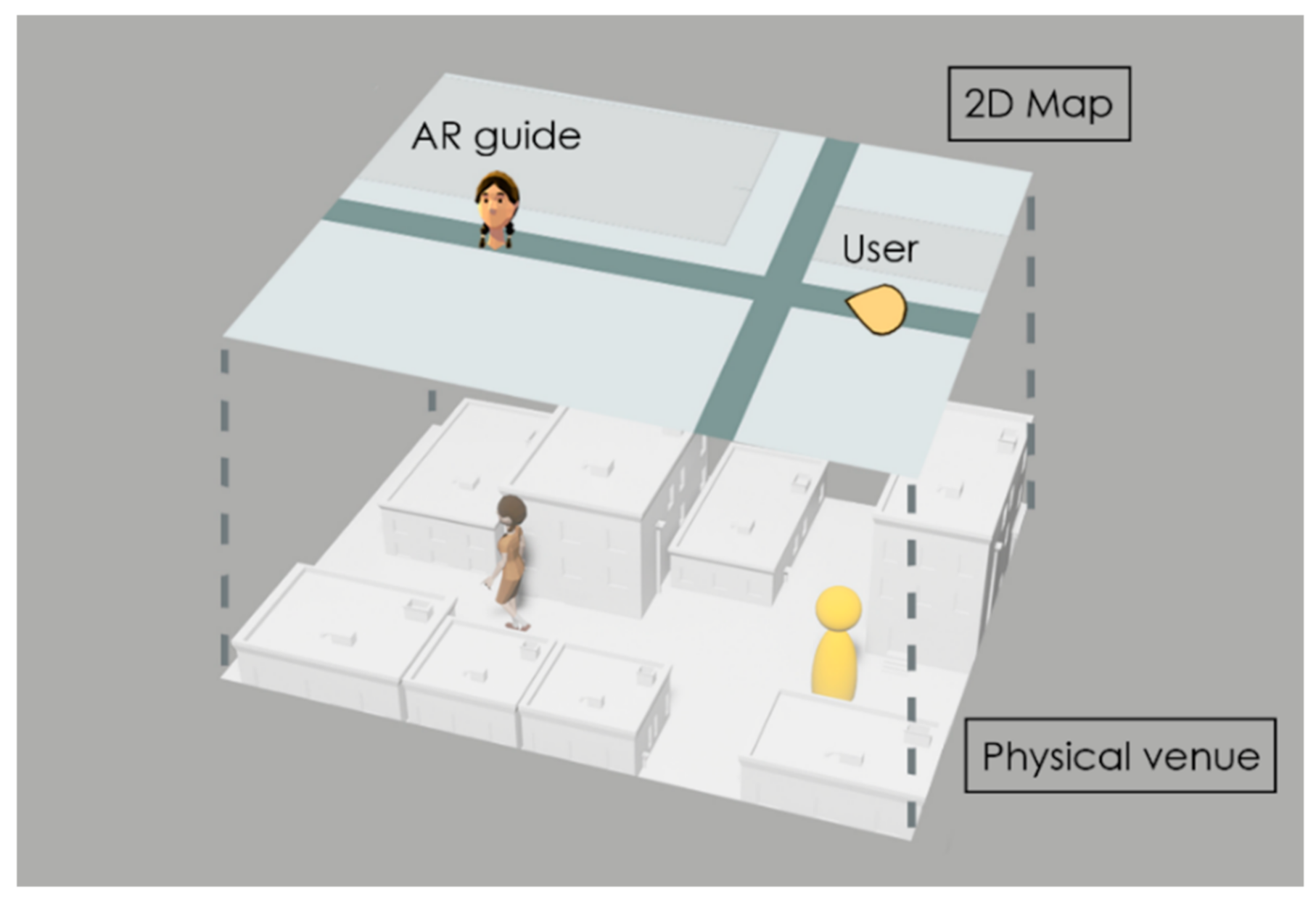

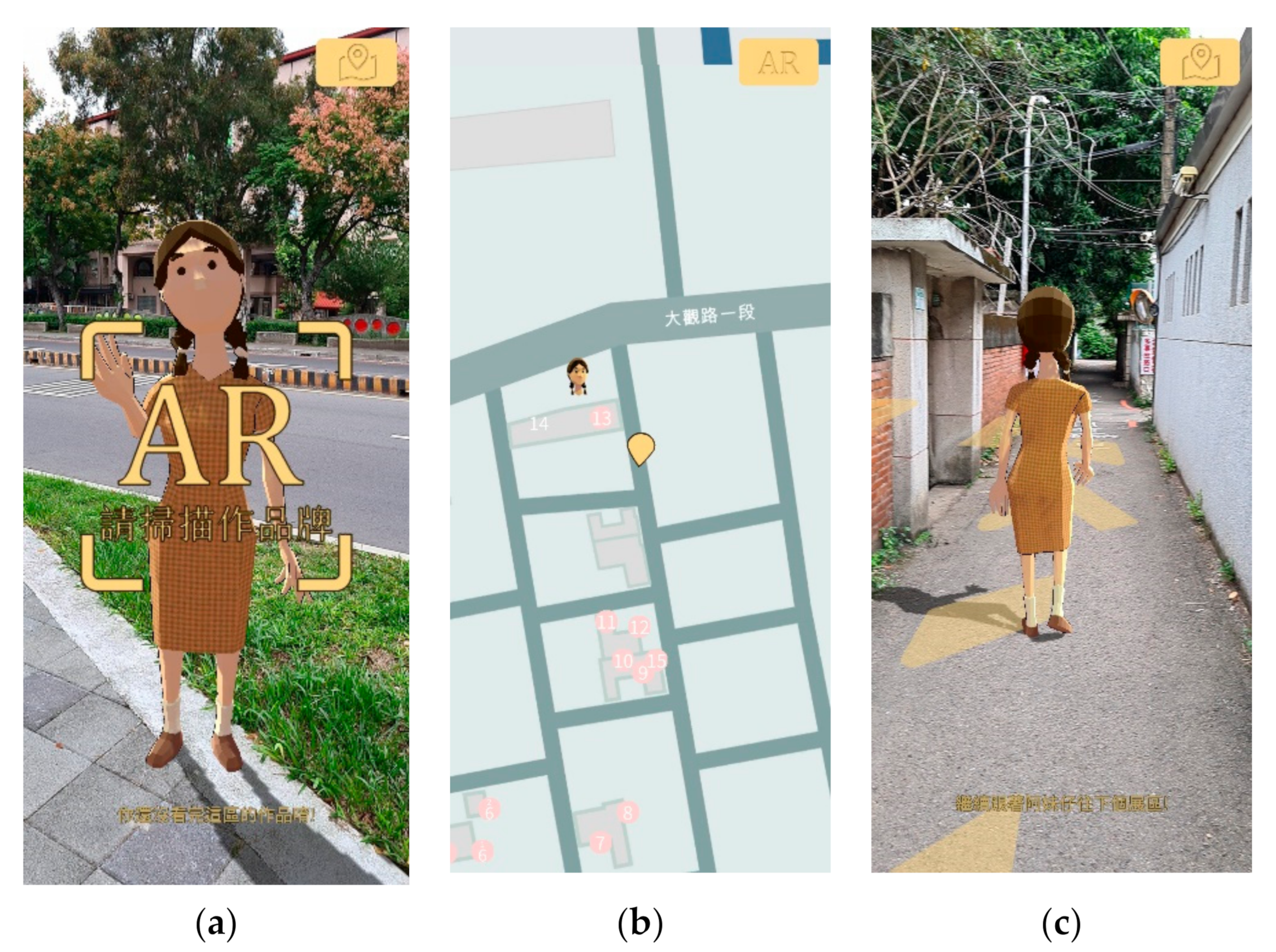

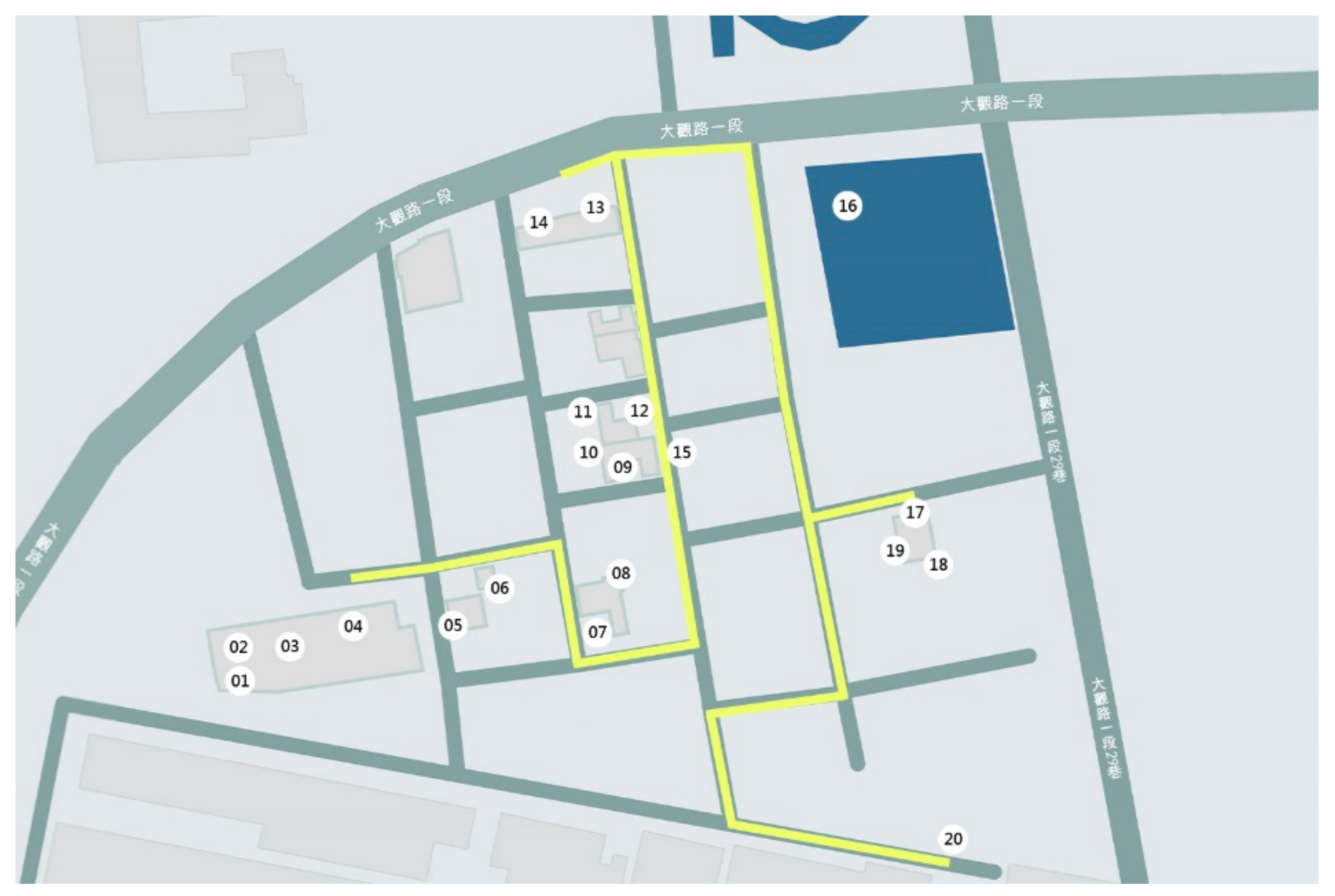
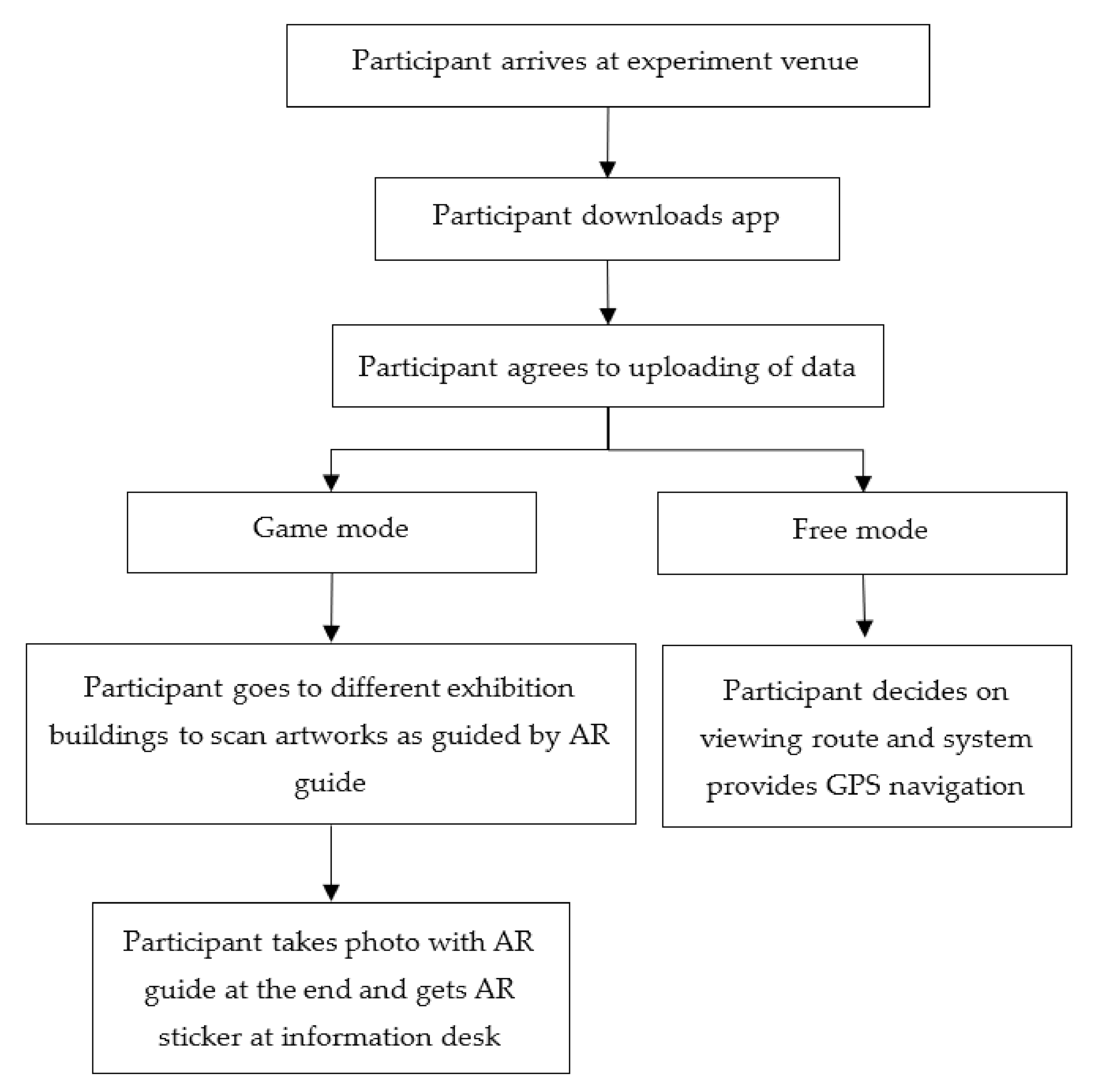
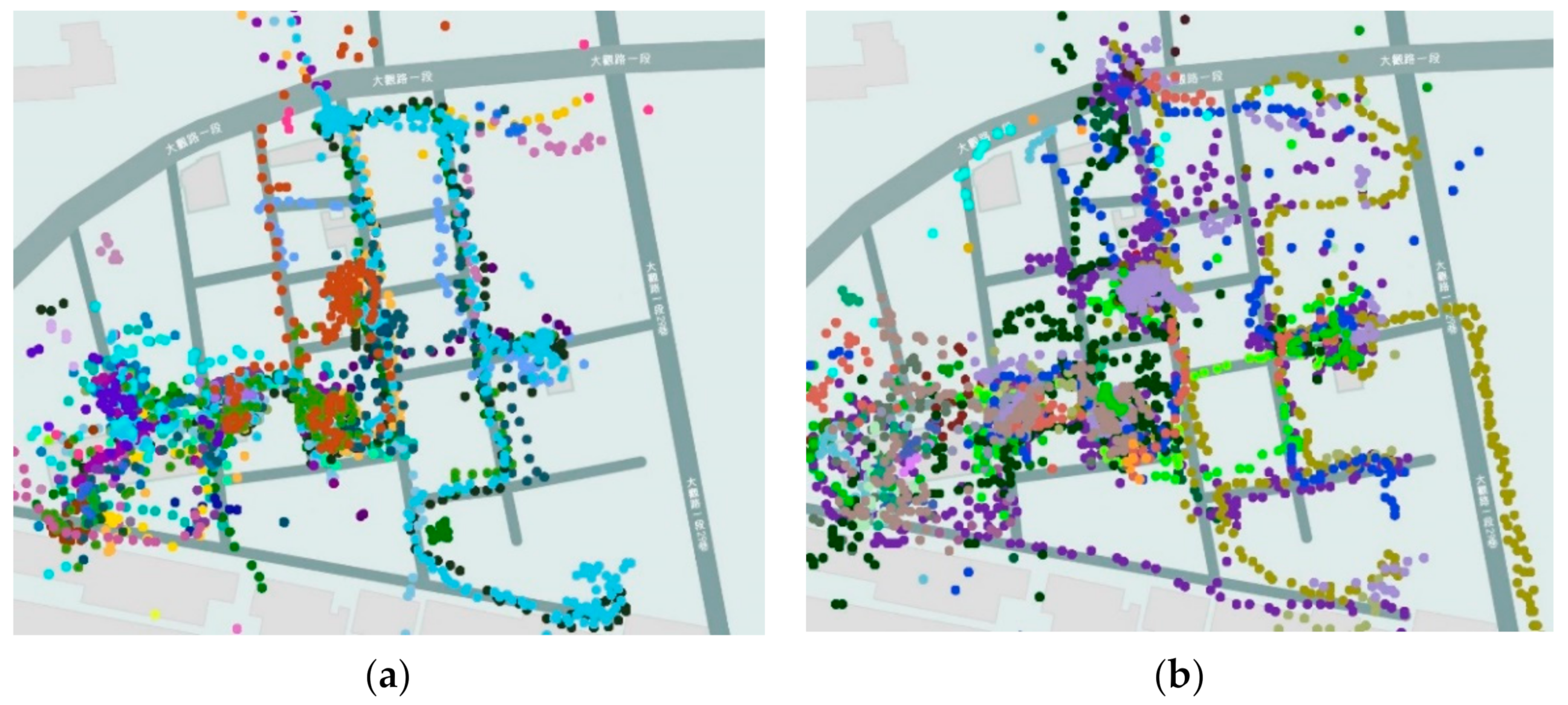
| Mode | No. of Samples | Time (s) | ||||
|---|---|---|---|---|---|---|
| Mean (n) | Standard Deviation (SD) | t-Value (t) | Degree of Freedom (df) | p-Value (p) | ||
| Free | 45 | 340.20 | 606.334 | 0.962 | 97 | 0.339 |
| Game | 54 | 243.78 | 382.659 | |||
| Mode | No. of Samples | Distance Travelled (m) | ||||
|---|---|---|---|---|---|---|
| Mean (n) | Standard Deviation (SD) | t-Value (t) | Degree of Freedom (df) | p-Value (p) | ||
| Free | 45 | 329.889 | 549.8836 | 1.451 | 59.099 | 0.152 |
| Game | 54 | 201.050 | 250.7699 | |||
Publisher’s Note: MDPI stays neutral with regard to jurisdictional claims in published maps and institutional affiliations. |
© 2022 by the author. Licensee MDPI, Basel, Switzerland. This article is an open access article distributed under the terms and conditions of the Creative Commons Attribution (CC BY) license (https://creativecommons.org/licenses/by/4.0/).
Share and Cite
Lee, C.-I. Benefit Analysis of Gamified Augmented Reality Navigation System. Appl. Sci. 2022, 12, 2969. https://doi.org/10.3390/app12062969
Lee C-I. Benefit Analysis of Gamified Augmented Reality Navigation System. Applied Sciences. 2022; 12(6):2969. https://doi.org/10.3390/app12062969
Chicago/Turabian StyleLee, Chun-I. 2022. "Benefit Analysis of Gamified Augmented Reality Navigation System" Applied Sciences 12, no. 6: 2969. https://doi.org/10.3390/app12062969
APA StyleLee, C.-I. (2022). Benefit Analysis of Gamified Augmented Reality Navigation System. Applied Sciences, 12(6), 2969. https://doi.org/10.3390/app12062969






